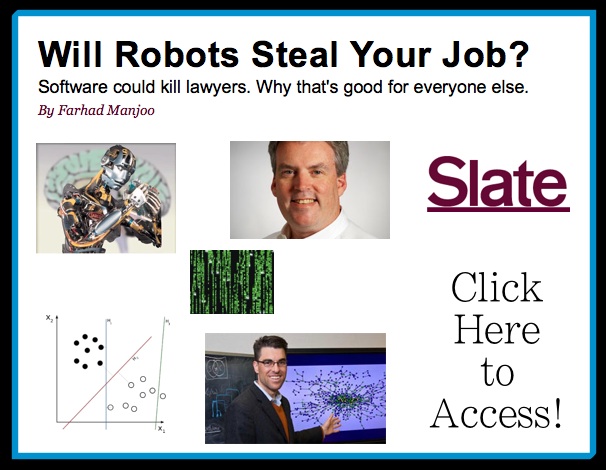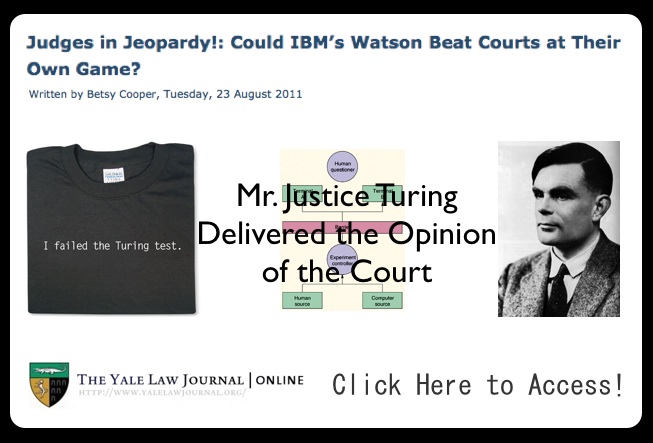Dan and I have written and spoken on legal informatics many times. Inevitably these conversations come to the same cut-and-paste list of informatics examples from legal search/retrieval and decision making. It’s struck me that these examples fall into two categories. The first category sits firmly in the 20th century, while the second category belongs in the 22nd century. I’ll support my argument below and conclude this introduction with a lead into what I’d like to call 21st century law. The rest of this series will provide living, breathing examples, leveraging new technologies and new paradigms that are useful today, in the 21stcentury.
20th Century Legal Informatics – Computers as Libraries
 Ask a typical lawyer how informatics affects their practice, and, if you’re lucky, they might mention that salary infographic their friend emailed them a few weeks ago. Data, modeling, statistics, and visualization might be seen as cute toys, but not real tools. Ask a typical lawyer how search affects them, however, and they’ll have no trouble producing a list of five-figure-per-seat services like Lexis, West, CCH, or RIA. So why is it that only search has enjoyed such a successful impact on practice? Is it because other informatics tools just aren’t useful?
Ask a typical lawyer how informatics affects their practice, and, if you’re lucky, they might mention that salary infographic their friend emailed them a few weeks ago. Data, modeling, statistics, and visualization might be seen as cute toys, but not real tools. Ask a typical lawyer how search affects them, however, and they’ll have no trouble producing a list of five-figure-per-seat services like Lexis, West, CCH, or RIA. So why is it that only search has enjoyed such a successful impact on practice? Is it because other informatics tools just aren’t useful?
My opinion on the matter is that search is the only informatics tool that fits into the current legal paradigm, which I’ll call the library model – law is a field of humans interpreting words, words live on documents, and documents live in libraries. Legal training focuses on reading and interpreting words and documents. Success in practice depends on locating, interpreting, and communicating information. Therefore, for a new tool to be accepted by lawyers, it must complement this library model to allow lawyers to locate, interpret, and communicate faster and better. From this standpoint, it’s easy to see why search has succeeded – it is a tool easily applied to language that facilitates the traditional library model of law.
The library model of law, while Aristotelian in ideals, still conveniently abstracts the underlying world away in an unmeasurable Platonic black box. As such, words, not numbers and functions, are the most convenient way to communicate states. It is hard to argue against this on any practical grounds. Despite the progress of science and the acceptance of measurement in modern society, many quantities integral to legal questions will remain unmeasurable. The best example, of course, is intent. Did he mean to kill her? Did they mean to commit fraud? While we have the ability to detect intent at a vague level through fMRIs, would we ever consent as a society to have “intent implants” that continuously measured and recorded our every impulse? The average gut reaction to Minority Report suggests not.
Philosophy aside, we can agree that human language is the most practical medium to practice law, and that search is the most practical tool to facilitate work in this medium. Computers are simply portable, accessible, and easily searched libraries, and the labor of law is still primarily conducted by humans. While technology can improve productivity, our creativity is constrained by the underlying library model of law, as well as the low expectations set by the 1L’s first venture into the stacks of the quiet, dusty library.
22nd Century Legal Informatics – Computers as Lawyers
 The second category is best understood through a hope and a struggle: IBM Watson and the International Association for Artificial Intelligence and Law (IAAIL). Watson embodies the hopes of 22nd century legal informatics, in which law is a field of computers building and interpreting models to make legal decisions. In the days and weeks after Watson’s victory against other Jeopardy! contents, there was a slew of articles on the automation of information services like law; even the ABA chimed in.
The second category is best understood through a hope and a struggle: IBM Watson and the International Association for Artificial Intelligence and Law (IAAIL). Watson embodies the hopes of 22nd century legal informatics, in which law is a field of computers building and interpreting models to make legal decisions. In the days and weeks after Watson’s victory against other Jeopardy! contents, there was a slew of articles on the automation of information services like law; even the ABA chimed in.
Likewise, the IAAIL embodies the struggles and failures of this model. Arguably one of the most forward thinking associations in academia, the IAAIL and its members have been presenting data models and ontologies, search methods, expert systems, and judicial reasoning for more than 30 years. Their approach to empiricism and rationalism in law predates acceptance in many other social fields. Many of their ideas might provide a significant improvement in the quality and cost of legal outcomes in situations ranging from negotation to arbitration to litigation. However, as a participant and former member myself, I will readily admit that the IAAIL has mostly failed to introduce these ideas into the mainstream of legal practice. Experts, not expert systems, still dominate evidence and testimony. Justices and judges, never computers, reason and decree from the bench. Even the elegant models of argumentation and reasoning are mostly ignored by legal educators.
The reason for this failure, in my opinion, is that these ideas, for all their worth, do not complement the library model of law outlined above. So long as this is the model of education and practice, many of IAAIL’s ideas will remain just that – ideas, drifting in the clouds (and I don’t mean Amazon Web Services). Progress will come, but slowly and in steps, measured by successes like Watson’s stunning and public expert system. And so we can agree for now that the future is promising, but certainly not here. Computers are not and will not functionally replace humans in most legal contexts any time soon.
21st Century Legal Informatics – Computers and Lawyers
 What can we do in the meantime while our robotic overlords are still incubating? How can we improve the quality and cost of law despite the constraints of our weak, organic bodies and slow-moving societies? I’d like to argue that the way forward is through 21st century law, not 20th or 22nd century law, as identified by the principles below:
What can we do in the meantime while our robotic overlords are still incubating? How can we improve the quality and cost of law despite the constraints of our weak, organic bodies and slow-moving societies? I’d like to argue that the way forward is through 21st century law, not 20th or 22nd century law, as identified by the principles below:
- Balance. Neither humans nor computers alone will provide optimal outcomes. 21st century law must allocate these two assets based on a solid understanding of process workflow and technology.
- Measure, but not too much. Measure whenever and wherever possible, but avoid promoting measurement when it isn’t the solution. Measurement drives further formalization of law, either by inductively determining better rules or by better evaluating rules.
- Change, but not too much. The library model of law is a natural paradigm for a species as expressive as ours. However, when we can measure, our languages are often worse approximations than mathematical models and numbers. Focus on cases where accurate, accepted, and easily evaluated models can be built, such as finance, and slowly chip away at the library model through these successes.
- Aim high. Don’t let expectations based on the library model set your bar for success. Apply and experiment with whatever technology is available to retrieve faster and analyze better. Just because Lexis and headnotes are faster and easier than a trip to the stacks doesn’t mean search and research shouldn’t be faster and better.
Sounds pretty easy, right? Stay tuned for examples to come, including e-Discovery, search, and legal rule exploration.
[Cross Posted from MichaelBommarito.com Blog]




 Ask a typical lawyer how informatics affects their practice, and, if you’re lucky, they might mention that salary infographic their friend emailed them a few weeks ago. Data, modeling, statistics, and visualization might be seen as cute toys, but not real tools. Ask a typical lawyer how search affects them, however, and they’ll have no trouble producing a list of five-figure-per-seat services like
Ask a typical lawyer how informatics affects their practice, and, if you’re lucky, they might mention that salary infographic their friend emailed them a few weeks ago. Data, modeling, statistics, and visualization might be seen as cute toys, but not real tools. Ask a typical lawyer how search affects them, however, and they’ll have no trouble producing a list of five-figure-per-seat services like  The second category is best understood through a hope and a struggle:
The second category is best understood through a hope and a struggle:  What can we do in the meantime while our robotic overlords are still incubating? How can we improve the quality and cost of law despite the constraints of our weak, organic bodies and slow-moving societies? I’d like to argue that the way forward is through 21st century law, not 20th or 22nd century law, as identified by the principles below:
What can we do in the meantime while our robotic overlords are still incubating? How can we improve the quality and cost of law despite the constraints of our weak, organic bodies and slow-moving societies? I’d like to argue that the way forward is through 21st century law, not 20th or 22nd century law, as identified by the principles below:







